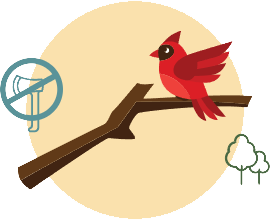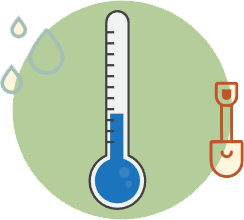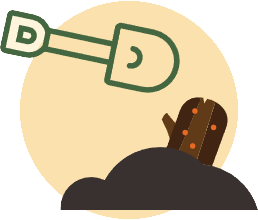Wildland Fire Management
Home / Wildland Fire Management

Wildland Fires
Wildland fires are uncontrolled fires that affect a range of ecosystems including forests and treeless ecosystems such as savannahs. Wildland fire can be a friend and a foe, either creating environmental benefits or wreaking havoc in ecosystems and communities.

Causes of Wildland Fires
Lightning: When lightning strikes an object it can release enough heat to ignite a tree or other fuels. Although lightning caused fires cannot be prevented, the risk from natural fires can also be reduced with fuel management and prescribed burning
Land clearing: Using fire for land clearing is a leading cause of wildfires, since most of the time, those fires are not controlled fires.
Agricultural purposes: Farmers in many parts of the world set fire to cultivated fields to clear weeds and waste before sowing a new crop. While this practice may be fast and economical, it is highly unsustainable, as escaped fires can lead to wildfires and soil degradation.
Burning garbage: Similarly, to escaped agricultural fires, fires from burning garbage can escape and cause a wildfire.
Hunting: Hunters deliberately cause fires as certain wildlife species forage on new vegetation.
Leaving camp sites unattended or not extinguishing firepits: A campfire is less likely to escape control if it is kept small. A large fire may cast hot embers long distances.
Improperly disposing cigarettes: cigarette butt material is combustible and can smolder for several hours before causing a fire.

Good vs. bad fires:
Fire can be extremely harmful to sensitive ecosystems such as rainforests while in pine forests it can maintain the structure and composition.
Good fires are low intensity fires that consume grass and small trees but do not kill the large trees. The “good fires” reduce fuels which are significant factors driving high intensity forest fires.
Conifers (pine trees) need low intensity fire to survive. Pine cones need fire or extreme heat to open up and disperse seeds. Fires eliminate or temporarily reduce competition for moisture, nutrients, heat, and light.
Bad fires, by contrast, kill mature trees damaging ecosystems. Fire can be deadly, destroying homes, wildlife habitat and timber, and polluting the air with emissions harmful to human health.

Effects of Wildfires:
Loss of Ecosystems and Biodiversity
Wildfires destroy wildlife and plant habitats. Wildlife are at high risk of death whereas plant species are burnt to ashes. Most animals are able to detect oncoming fires and migrate early. Those that can’t move faster are killed. Since plant life that supports life in the area is burnt down, animals have to look for habitats elsewhere.
Forest Degradation
Thousands of acres of trees and vegetation cover are wiped out, reducing the quality of certain forest features like soil fertility, biodiversity, and ecosystems.
Air Pollution
During forest fires, the quality of air we breathe declines. The huge clouds of smoke instigated by wildfires lead to massive air pollution.
Soil Degradation
Wildfires kill beneficial soil microorganisms that are responsible for breaking down the soil and promoting soil microbial activities, making soils vulnerable to erosion.
Economic Losses
Wildfires devastate everything in their path including property. In addition, financial resources are required to put out or control the fire.

Preventative Measures
The most important thing about human-caused wildfires is that they are preventable. The easiest way to fight a wildfire is to prevent it from starting. The Forest Department promotes preventive measures such as prescribed burns in the Mountain Pine Ridge Forest Reserve and assists co-managers in fighting wildfires in other protected areas.
Campfires Safety:
Where campfires are allowed, choose a site with an existing ring. Fire pits in established campgrounds are the best spots. Clear the site down to mineral soil, at least five feet on all sides, and circle it with rocks. Store unused firewood a good distance from the fire.
Add firewood in small amounts as existing material is consumed. Placing a log on the fire rather than dropping it from a height will prevent a big shower of sparks.
Have a shovel and a bucket of water nearby to extinguish any escaped embers. When you are ready to leave, drown all embers with water, stir the coals, and drown again. Repeat until the fire is dead out. If it is too hot to touch, it is too hot to leave.
Agricultural Burn Safety:
Farmers should clear (cleared to mineral soil) a fire line no less than 6 to 12 feet wide around the perimeter of the area to be burned. All lianas and dried leaves from large cohune trees occurring in or immediately adjacent to the burn area should be removed. Burns should not occur during the hottest part of the day and should be set between the hours of 6:00 am to 10:00 am or 3:00 pm to 6:00 pm.
Inform proprietors of adjacent parcels prior to executing the burn to put them on alert. Water supply should be available for emergency use to reduce the risk of escaped fires. After a burn, ensure flames and burning material (stumps and logs) are completely extinguished.

Don’t throw lit cigarettes:
Never throw lit cigarettes, smoking materials, or matches out of your car, or on the ground. Cigarettes and matches both have enough heat to create a spark. Make sure any cigarettes are completely extinguished before you throw them in the trash. Many wildfires can start by carelessly flicking a cigarette bud on the ground, especially during dangerously dry conditions.

